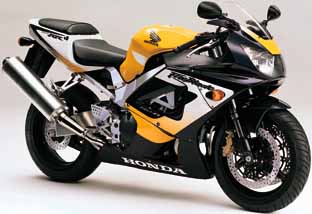Road tests
Honda CBR900RR
May 2000

Eight-or-so years down the track from its initial release the Honda
Fireblade has got better.
It's not as scarily awesome as the first model - which was unusually
light, powerful, and flighty for its time. Bikes such as Yamaha's spectacularly
successful R1 have come along in the meantime, putting the Blade in its
place - or in context.
Honda Oz released a particularly fine version of the Blade series in
1998 (the last model before this). While it had less sheer stomp than the
R1, and more weight, it was a lesson to other manufacturers in user-friendly
hi-po manners.
Roll up to year 2000 and my biggest concern was the Blade might have
lost its easy "ride me hard" manners in pursuit of the R1's (now in its
second generation) credentials.
It hasn't. Long-term Blade riders will find a lot to identify with in
the new bike. A similar raw and angry feel. But they'll be genuinely surprised
by the far slimmer between-the-knees profile (the old-gen Blades always
felt 'fat'). It makes the bike feel like a biggish 600, even though the
specs say otherwise.
Power spread has increased noticeably over the old bike - oh that old
dunger that I really liked? Honda has introduced a couple of gadgets:
1. H-Tev, which is a cable-operated exhaust valve in the exhaust system
that is meant to alter the flow properties to improve power spread;
2. H-Vix, which is apparently a shutter in the airbox with similar
intention.
That goes with the in-house fuel injection system.
All fine so far, though the bike goes from mild to "who moved that scenery?"
somewhere around 6000rpm. It's strong through the range, but the six to
seven leap of urge is stunning and remains strong through to the 11,000rpm
power peak.
My experience with the bike was a one-day back-roads blast, with one
of two quick sessions thrown in. The upshot is that, while the Blade is
not terribly comfy (oh, really?), it has not lost the user-friendly aspect.
It has also gained some seriously good suspension which seems to get better
as you turn up the wick.
We rode over some smooth, then some really snotty, roads and the bike's
manner had "trust me" written all over it. (All-up, something like 600km
by the time I returned the machine.) Feel at the brakes was good, the suspension
exceptional, and steering among the best for a hard play in conditions
that were often completely unpredictable.
A bonus is a stunning set of headlights, which work a treat in ordinary
conditions - perhaps the best stock set out there.
Comfort is ordinary, and the pillion set-up a token effort. Which is
about what you'd expect for the 900 sport class. It's a day-ride motorcycle,
and a very handy tool for a track session.
I can't say whether it's better or worse than a current R1 or ZX-9R
without direct comparison. But will suggest both the competitors have a
very, very, competent bike to mess with. If you're a Honda fan, you'll
love it.
(Note: a few of the first demo bikes copped holed radiators thanks to
stone damage. Given Honda's good record with warranty claims, we wouldn't
be overly concerned at this stage.)
Guy Allen
Quick Specs
Displacement: 929cc
Bore x stroke: 74 x 54mm
Compression ratio: 11.3:1
No. of cylinders: 4
Cooling: liquid
Max power (claimed): 152ps 11,000rpm
Max torque(claimed): 10.5 N-m 9000rpm
Primary drive type: gear
Clutch type: wet
Gears: 6
Final drive type: chain
Lubrication: wet sump
Fuel capacity: 18 litres
Carburetion: injection
Front/rear suspension type: USD 43mm cartridge fork with preload, rebound
& compression adjustment/monoshock with preload, rebound and compression
adjustment
Front brakes: twin four-piston calipers on 330mm discs
Rear brake: single-piston caliper on 220mm disc
Front/rear tyre sizes: 120/70-17, 190/50-17
Frame type: twin-spar alloy
Wheelbase: 1400mm
Seat height: 815mm
Dry weight claim: 170kg
Price: $18,090 (May 2000)
Detailed specifications and images
[Roadtests | Motorcycle
Books]
![]()

![]()